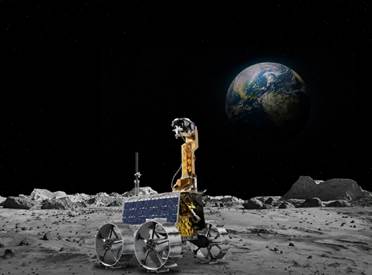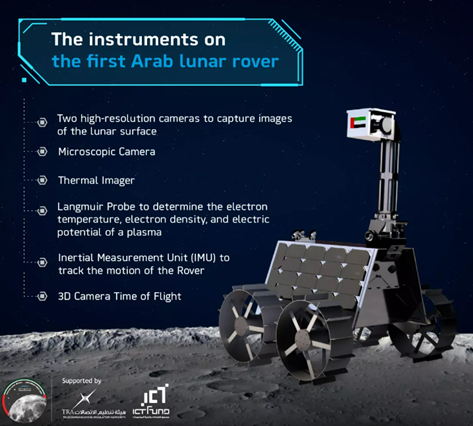Description

Disclaimer: Copyright infringement not intended.
Context
- A SpaceX Falcon 9 rocket carried into space the first ever Arab-built lunar spacecraft. It was launched from the Cape Canaveral Space Force Station in Florida.
Details
- The Rashid Rover was built by Dubai’s Mohammed bin Rashid Space Centre (MBRSC), in the United Arab Emirates (UAE), and is being delivered by the HAKUTO-R lander, engineered by Japanese lunar exploration company ispace.
- The mission is due to arrive at Moon around April 2023. According to Mohammed Bin Rashid Space Centre (MBRSC) in Dubai, the Rashid rover will provide 'novel and highly valued data, images, and insights,' as well as 'collect scientific data on matters relating to the origin of the solar system, our planet and life.'
- Weighing only 10kg with payload and measuring 70cm in height; 50cm in both length and width, Rashid Rover – which is almost the same size as a plane’s regular carry-on luggage – is designed as the world’s most compact rover to traverse and explore the Moon’s surface.
- It is expected to land on the Atlas Crater, located at 47.5°N, 44.4°E on the Moon’s south-eastern outer edge of Mare Frigoris (Sea of Cold), by April 2023.
- The lunar rover will operate on solar panels that were mounted at a certain angle to maximize the collection of solar energy.
- It will carry four cameras, including two main cameras – a microscopic and a thermal imaging camera – in addition to sensors and systems equipped to characterize the soil, dust, radioactive and electrical activities, and rocks on the Moon’s surface.
- The four-wheeled rover will perform numerous scientific experiments to measure the effectiveness of some materials on the lunar surface, such as the efficiency of adhesion of the rover wheels to the lunar surface, and explore the process of overcoming natural obstacles on the moon.
.jpg)

Surviving harsh environment
- The Moon’s environment is very harsh. Its temperature drops to as low as minus 173 degrees Celsius, from as high as 127 degrees Celsius, when sunlight hits the Moon’s surface. But Rashid Rover is equipped with the latest technologies that can resist the lunar surface temperature.
Significance
- Rashid Rover will study the surroundings for at least one lunar day (equivalent to 14 Earth days). Its Langmuir probe, for instance, can help scientists better understand the electrically charged environment at the lunar surface, which is apparently caused by the solar wind which is a stream of charged particles from the sun.
- This ambitious mission undertaken by the UAE to study the surface of the Moon is considered a gateway for future exploration of other planets, especially for Mars under the Mars 2117 programme.
- Alongside the lunar gateway, there are also efforts to build base stations for human settlement on the moon that can be used to support longer human missions. The Moon will be used as a base camp where we fuel and continue the journey to farther celestial bodies in our solar system.
.jpg)
https://newsonair.gov.in/News?title=UAE-successfully-launches-first-ever-Arab-Built-lunar-spacecraft&id=452160






.jpg)











